
The Pazzi were a powerful family in the Republic of Florence. Their main trade during the fifteenth century was banking. In the aftermath of the Pazzi conspiracy in 1478, members of the family were banished from Florence and their property was confiscated; the family name and coat-of-arms were permanently suppressed by order of the Signoria.

The Frescobaldi are a prominent Florentine noble family that have been involved in the political, social, and economic history of Tuscany since the Middle Ages. Originating in the Val di Pesa in the Chianti, they appear holding important posts in Florence in the twelfth century.

Palazzo Strozzi is a palace in Florence, Italy.

The Palazzo Medici, also called the Palazzo Medici Riccardi after the later family that acquired and expanded it, is a Renaissance palace located in Florence, Italy. It is the seat of the Metropolitan City of Florence and a museum.

The Albizzi family was a Florentine family originally based in Arezzo, who were rivals of the Medici and Alberti families. They were at the centre of Florentine oligarchy from 1382, in the reaction that followed the Ciompi revolt, to the rise of the Medici in 1434. They were active members of the Arte della Lana, Florence's wool guild. The Guilds played a central role in the governance of the Republic of Florence during the medieval period and guild members constituted Florence's political and economic oligarchy.

Palla di Onofrio Strozzi was an Italian banker, politician, writer, philosopher and philologist.
Alessandri is an Italian surname. Notable people with the surname include:
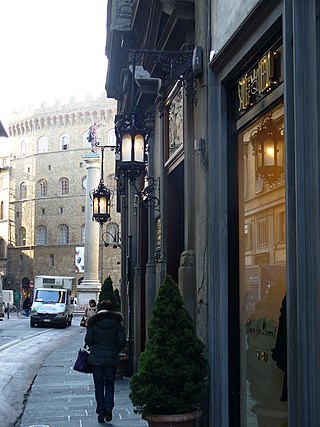
Via de' Tornabuoni, or Via Tornabuoni, is a street at the center of Florence, Italy, that goes from Antinori square to Ponte Santa Trinita, across Santa Trinita square, distinguished by the presence of fashion boutiques.
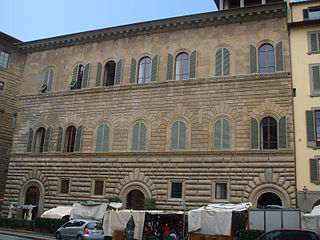
Palazzo Gondi is a palace in Florence, Italy, located a block from Piazza della Signoria. It was built in 1490 under design by Giuliano da Sangallo, who was inspired by other major works of stately buildings in the city, such as Palazzo Medici and Palazzo Strozzi. Among the elements borrowed from these earlier works are the cube-shape set around a central courtyard, the ashlar sloping on each of three floors, and the arched windows.
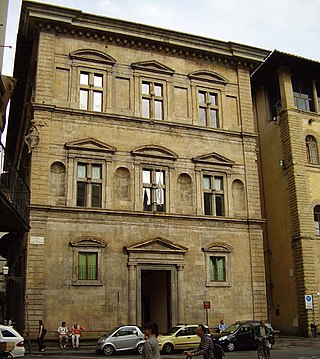
The Palazzo Bartolini Salimbeni is a High Renaissance-style palace located on Via de' Tornabuoni on Piazza Trinita in central Florence, Italy.

Palazzo Antinori is a Renaissance palace located at the north end of Via de' Tornabuoni, where it makes an odd corner with Via dei Pecori, Via del Trebbio, and converts into Via dei Rondinelli, in Florence, Italy.

Palazzo Capponi alle Rovinate is a late-Gothic and early Renaissance-style residential palace located on Via de' Bardi in Florence, region of Tuscany, Italy. There are apparently three other palaces once associated with the Capponi family:

The Alberti family was a major political and noble family in Florence, allies of the Medicis, with trading agencies across Europe.

Palazzo dello Strozzino is a Renaissance palace in Florence, Italy. The stone Renaissance facade is located on Piazza degli Strozzi, diagonal to the Southeast corner of the imposing Palazzo Strozzi. The Northern façade on Via dei Anselmi houses the entrance to the Cinema Odeon.

The Palazzo Pazzi, also known as the Palazzo della Congiura or Palazzo Pazzi-Quaratesi is a Renaissance-style palace. It is located on Via del Proconsolo 10 at the corner with Borgo Albizzi in Florence, region of Tuscany, Italy. The palace is between the Palazzo Nonfinito and the Palazzo Pazzi-Ammannati to the north.

The Palazzo Giugni, also called the Palazzo Firenzuola, is a late-Renaissance or Mannerist architecture palace designed by Bartolomeo Ammanati, and located on Via degli Alfani #48 in the quartiere San Giovanni of Florence, region of Tuscany, Italy. It is located down the street from the Brunelleschi's church of Santa Maria degli Angeli.
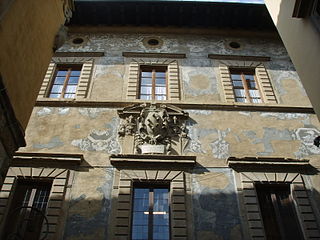
The Palazzo Ramirez de Montalvo, also known as Palazzo Matteucci is a palace located on Borgo degli Albizi #26 in central Florence, region of Tuscany Italy.
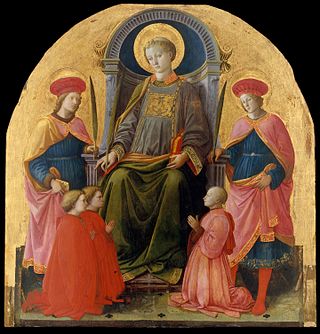
The Alessandri Altarpiece is a tempera on panel painting by Filippo Lippi, also known as Saint Lawrence Enthroned Between Saints Cosmas and Damian and Donors and Saint Lawrence Enthroned with Saints and Donors. It is now in the Metropolitan Museum of Art in New York.

Tommaso (Maso) degli Albizzi was a Florentine statesman, from 1382 to 1417 the head of the oligarchic party that effectively ruled the Florentine Republic.
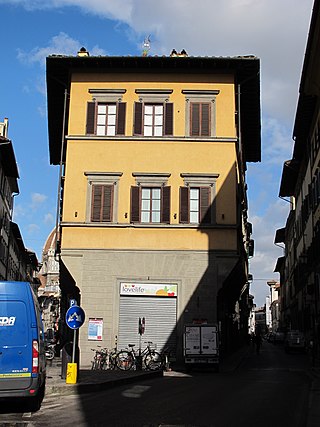
Palazzo degli Sporti, or Busini Ugolini, is a civic building in the historical centre of Florence, located between Via dell'Oriuolo 10 and Via Sant'Egidio in Florence, in front of an unnamed small square near the San Pierino arch, where it also leads to Borgo Pinti.




















